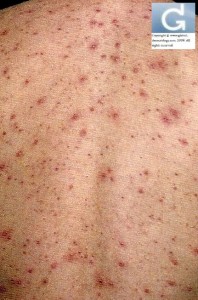Chicken pox
What is chicken pox ?
- It is an infectious condition caused by a virus called Varicella Zoster Virus (VZV).
- It typically affects children.
Does it always present ?
- Once infected, lesions present only after two to three weeks (incubation period).
- In 30% of cases, there is no obvious manifestation (subclinical).
How does it look like ?
- At first redness appears on the trunk, scalp and mouth (oral mucosa).
- Then lesions become blisters and then pustules.
- At the end they “dry out” (crusting), leaving scabs.
- The main thing to remember is that there is no typical individual feature; the easiest is to detect a mixed group of lesions at different stages of development.
- There is intense itching. The scratching of lesions leads to infection and subsequent scarring.
- The palms and soles are spared.
Is it contagious ?
- Chicken pox is extremely contagious and isolation is a requirement.
- The condition remains contagious until all the lesions have “dried out”.
How is it treated ?
- Symptomatic treatment is most often enough and consists of drying lotions (astringents) , disinfectants, topical and systemic antibiotics, antihistaminics.
- Acyclovir slightly reduces the course of the disease.
- Isolation is the single most important attitude.
- If isolation is not possible, inpatient treatment may be required.
- Also intravenous treatment with anti-VZV immunoglobulins is necessary if there is pulmonary (herpetic pneumonitis) or cerebral (herpetic encephalitis) involvement.
Is it preventable ?
- Yes. Varicella vaccine is a routine childhood immunization.
Chicken pox during pregnancy: what are the risks ?
- There are risks for the baby at all trimesters (I and II: varicella embryopathy syndrome, III: congenital varicella).
- It is important in those cases to be closely followed by a paeditrician and gynaecologist.
What are the long term consequences ?
- The VZV virus remains in the dorsal nerve ganglia and can be reactivated many years later.
- In that case it produces a localized (dermatomal) eruption of blisters and is preceeded by tingling / pain. This condition is called shingles:
- the biggest problem is the presence of an “electrical” pain after the eruption subsides (post herpetic neuralgia). This problem occurs quite often in individuals aged 60 and over.
- a vaccine is available against shingles.
Biblography: Sterry W. et al. Thieme Clinical Companions: Dermatology. 1st edition in English.
Category : Chicken pox - Modifie le 02.27.2013Category : Varicelle - Modifie le 02.27.2013





